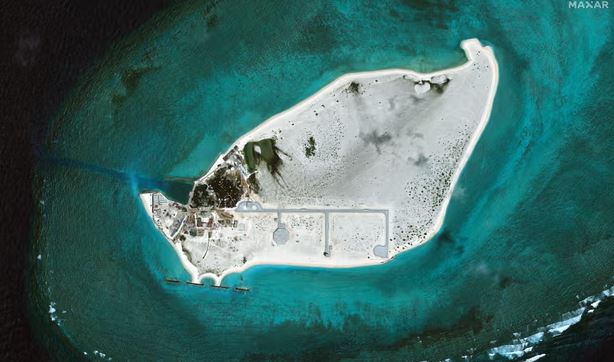“Upgraded Triton Island Outpost in Paracel Archipelago Enhances China’s Surveillance Capabilities in the Region”
China Enhances Surveillance with New Counter-Stealth Radar on Disputed South China Sea Reef
The Chinese military is reportedly constructing a counter-stealth radar system on a disputed reef in the South China Sea, a development that could significantly bolster its surveillance capabilities in the region, according to satellite imagery. An analysis by Chatham House indicates that China is upgrading its outpost on Triton Island, located in the southwestern corner of the Paracel archipelago. This upgrade may include a launching point for an anti-ship missile battery, along with the advanced radar system.
“New Chinese Radar System Sends Strong Message on Stealth Aircraft Capabilities, Expert Says”
Michael Dahm, a senior resident fellow at the Mitchell Institute of Aerospace Studies, commented on the implications of China’s new radar system, stating, “By constraining the US ability to operate stealth aircraft, and threaten stealth aircraft, these capabilities in the South China Sea send a powerful signal to US allies and partners in the region that US advanced technologies may not be able to stand up to the PLA (People’s Liberation Army).”
“China Expands Counter-Stealth Radar Network with Triton Island Construction”

Similar counter-stealth radar systems, known as Synthetic Impulse and Aperture Radar (SIAR), have already been established to the south on Subi Reef in the Spratly Island chain and on Hainan Island to the north. The construction on Triton Island will fill a gap in China’s surveillance coverage. Michael Dahm remarked, “Triton Island is another brick in the wall,” noting that China has spent three decades developing technologies to counter the advanced stealth capabilities of the US.
Triton, a reef covering approximately 120 hectares, is located in the far southwestern corner of the Paracel archipelago, which China has controlled since a violent conflict with Vietnam in 1974. The area is also claimed by Taiwan and Vietnam.
“China’s Claims in South China Sea Persist Despite International Tribunal Rejection”
China asserts extensive claims over the South China Sea, despite a ruling from an international tribunal that rejected its arguments. The strategic waterway sees overlapping claims from several nations, including the Philippines, Vietnam, Malaysia, Brunei, and Taiwan.
“US Stresses Importance of South China Sea Amid Rising Tensions”
Although the US is not a claimant in the South China Sea disputes, it emphasizes that the key trade route is vital to its national interest and frequently conducts freedom of navigation operations in the area. The US maintains a mutual defense treaty with the Philippines, pledging to protect the nation from attacks in the South China Sea.
In recent years, China has faced repeated accusations of aggressive behavior in these waters, with analysts warning that such confrontations could escalate into conflict. Earlier this month, Vietnam accused Chinese law enforcement personnel of assaulting ten Vietnamese fishers and confiscating approximately four tonnes of their catch near the Paracel Islands. These islands are not only rich fishing grounds but also contain significant oil and gas reserves.
“Vietnam Expresses Concerns Over New Construction on Triton Island”
Any construction on Triton Island—located 135 nautical miles east of Vietnam’s mainland and 170 nautical miles south of China’s Hainan—is expected to raise significant concerns in Hanoi. According to Chatham House’s analysis, the intelligence structures being developed on Triton would “significantly diminish [Vietnam’s] capacity to operate undetected in the area.”
“China’s Triton Island Construction Enhances Surveillance and Military Capabilities”
According to Chatham House, alongside the existing radar on Triton Island, which can detect sea-going vessels, Beijing is now positioned to track Vietnamese air movements, providing advance warning of Hanoi’s maneuvers in the region, including efforts to access oil and gas deposits. The radar system may also complicate navigation for the US, British, and Australian navies in the surrounding waters.
Chatham House indicates that multiple construction projects are underway on Triton, including a large pad at the end of a road network that could serve as a launching point for a mobile anti-ship missile battery. Another structure visible in satellite imagery may function as a storage facility for missile transport vehicles.
Michael Dahm noted that this construction reflects efforts to fortify the southwestern edge of the Paracels. “Triton Island really represents the weak point in the fortress,” he said, pointing out that China has already established significant capabilities on Woody Island and other reefs in the northeastern part of the archipelago.
